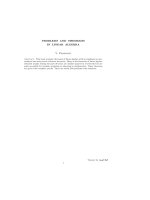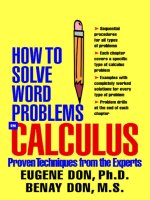Algebra word problems workbook chris mcmullen
Bạn đang xem bản rút gọn của tài liệu. Xem và tải ngay bản đầy đủ của tài liệu tại đây (8.62 MB, 341 trang )
www.pdfgrip.com
www.pdfgrip.com
Improve Your Math Fluency
monkeyphysicsblog.wordpress.com
improveyourmathfluency.com
chrismcmullen.com
www.pdfgrip.com
CONTENTS
INTRODUCTION
1 STRATEGIES AND TIPS
2 ALGEBRA REFRESHER
3 EXAMPLES
4 WORD PROBLEMS
ABOUT THE AUTHOR
www.pdfgrip.com
INTRODUCTION
This workbook is designed to help practice solving standard word problems.
Every problem is fully solved using algebra: Simply turn the page to check
the solution.
The first chapter offers some tips for solving word problems, the second
chapter provides a quick refresher of essential algebra skills, and the third
chapter includes several examples to help serve as a guide for how to solve
algebra word problems.
A variety of problems are included, such as:
• age problems
• problems with integers
• relating the digits of a number
• fractions, decimals, and percentages
• average values
• ratios and proportions
• problems with money
• simple interest problems
• rate problems
• two moving objects
• mixture problems
• people working together
• problems with levers
• perimeter and area
May you (or your students) find this workbook useful and become more
fluent with algebra word problems.
www.pdfgrip.com
1 STRATEGIES AND TIPS
Read the Problem Carefully
First read the entire problem. Be sure to read every word. A single written
word can make a big difference in the solution. It’s a common mistake for
students to focus so much on the numbers that they don’t notice a very
important word. As you read the problem, circle or underline what you
believe will be key information:
• numbers like 12 years, $3.75, or 25%
• written numbers like two, one-third, or none
• key words that relate to mathematical operations like total, increased
by, or tripled
• what you are solving for, like Anna’s age or the number of apples in
the cart
Identify the Given Information
The information given in the problem is used to solve for the desired
unknown, so the first step is to gather the information that you know. You
can do this by circling or underlining the numerical information in the
problem, or you could make a table of this information.
• First identify all of the numbers like 3 bananas or 5 days.
• Beware that some numbers are stated using words, like writing “five”
instead of 5, a “dozen” instead of 12, or “doubled” instead of 2 times.
• The number “zero” is often disguised. For example, if a problem
states “there are no grapes left,” this is equivalent to stating that there
are zero grapes.
What Are You Solving for?
Read carefully to determine what the problem is asking you to find. Some
problems ask a question like, “What is Julie’s age?” or “How far did Pat
walk?” Other problems state the question in a sentence like, “Determine the
www.pdfgrip.com
number of apples in the barrel.” Some questions ask for more than one
answer, like “How old are Liz and Tim?”
www.pdfgrip.com
Indicate What Each Unknown Represents
In the beginning of the solution, it helps to write a phrase like the example
below in order to remind you what each unknown represents. The unknown
should usually represent what you are trying to solve for. That way, your
solution will be complete once you solve for the unknown.
x = the original number of cookies
Multiple Unknowns
If there are two (or more) unknowns, try to let one variable represent the
smallest unknown. For example, suppose that Melissa is three years older
than Doug. In this case, Doug is younger, so you could let x represent
Doug’s age:
x = Doug’s age
x + 3 = Melissa’s age
If there are two (or more) unknowns, but it is difficult or inconvenient to
express both unknowns in terms of a single variable (as we did above), it is
possible to use two different variables. If you use multiple variables, you
will need to write down more than one equation. If there are two variables,
you will need two equations.
x = bananas
y = oranges
3x – 2y = 14
4x + 5y = 57
www.pdfgrip.com
Relating the Unknowns to the Given Information
Write down an equation to help you solve for the variable. (If there are two
different variables, you will need to write down two different equations.)
The language in the problem helps you relate the variables to the given
information. Translate the words into symbols by looking for words that
relate to mathematical operations. Note that the examples in the following
tables are designed to help with common expressions, but do not account for
every possible way for the English language to describe each mathematical
operation: You need to think about the wording of every problem.
www.pdfgrip.com
www.pdfgrip.com
www.pdfgrip.com
www.pdfgrip.com
www.pdfgrip.com
www.pdfgrip.com
www.pdfgrip.com
Beware of Possible Extraneous Information
Occasionally, a problem includes extraneous information that isn’t needed to
solve a problem. Although most problems give you only the information that
is needed, it is a good habit to ask, “Which information is needed to solve
the problem?” Remember that a rare problem may include numbers that
aren’t relevant to the solution.
Be Confident and Determined
Successful students know that a solution exists. They are determined to
figure it out.
www.pdfgrip.com
Working with Integers
The following features are common in word problems:
• Represent two consecutive integers with x and (x + 1). A third
consecutive integer would equal (x + 2), and so on.
• Represent two consecutive even or odd integers with x and (x + 2).
(The two numbers will have a difference of 2 whether they are both odd
or both even.) If there is a third consecutive even or odd integer, that
equals (x + 4).
• To solve for the digits of a two-digit number, multiply the tens digit by
10 and the units digit by 1. For example, if the problem states that the
units digit is 5 times the tens digit, let the tens digit equal x, the units
digit equals 5x, and the number equals 10(x) + 1(5x) = 10x + 5x = 15x.
Suppose that you solve the problem and obtain x = 1. In this example,
the tens digit is 1, and the units digit is 5. The number is 10(1) + 1(5) =
15.
• To solve for the digits of a three-digit number, multiply the hundreds
digit by 100, the tens digit by 10, and the units digit by 1. For example,
if the problem states that the tens digit is twice the units digit and that
the hundreds digit is triple the tens digit, let the units digit equal x, the
tens digit equals 2x, the hundreds digit equals 3(2x) = 6x, and the
number equals 100(6x) + 10(2x) + 1(x) = 600x + 20x + x = 621x.
Suppose that you solve the problem and obtain x = 1. In this example,
the units digit is 1, the tens digit is 2, and the hundreds digit is 6. The
number is 100(6) + 10(2) + 1(1) = 621.
• To reverse the digits of a two-digit number, swap the place of the tens
and units digit. For example, if a problem states that the units digit is x
and the tens digit is x + 2, the number is 10(x + 2) + 1(x) = 10x + 20 +
x = 11x + 20 and the reversed number is 10(x) + 1(x + 2) = 10x + x + 2
= 11x + 2. Suppose that you solve the problem and obtain x = 5. In this
example, the units digit is 5, the tens digit is 7, the number is 10(7) +
1(5) = 75 and the reversed number is 10(5) + 1(7) = 57. Observe that 75
and 57 indeed have their digits reversed.
www.pdfgrip.com
Sum, Product, Difference, and Ratio
If you know the sum, product, difference, or ratio of two numbers, but aren’t
told what either number equals, let the following examples serve as a guide:
• If the sum of two numbers equals 42 (for example), let one number be
x and the other number will be (42 – x).
• If the product of two numbers equals 36 (for example), let one number
be x and the other number will be 36/x.
• If the difference between two numbers is 5 (for example), let one
number be x and the larger number will be (x + 5).
• If the ratio of two numbers is 3 (for example), let one number be x and
the larger number will be 3x.
www.pdfgrip.com
Fractions, Decimals, and Percentages
Following are some tips for dealing with fractions, decimals, and
percentages:
• Divide by 100 to convert a percent into a decimal.
40% = 40/100 = 0.4
• When there are decimals in an equation, multiply the entire equation
by the power of 10 needed in order to remove all of the decimals.
0.24x + x = 6
multiply by 100
24x + 100x = 600
• When there are fractions in an equation, multiply the entire equation
by the lowest common denominator.
x/2 – 1/x = 1/3
multiply by 6x
3x2 – 6 = 2x
• The phrases “increased by” or “decreased by” are compared to 100%
(or 1).
* If x increases by 20%, this means 1.2x (since 120% = 1.2).
* If x decreases by 1/4, this means 3x/4 or 0.75x (since 1 – 1/4 = 3/4 =
0.75).
www.pdfgrip.com
Ratios and Proportions
A ratio expresses a fixed relationship in the form of a fraction. For example,
if there are 300 girls and 200 boys in a particular school, the ratio of girls to
boys attending that school is 3 to 2. We could express this ratio with a colon
(3:2), as a fraction (3/2), as a decimal (since 3/2 = 1.5), or as a percent
(150%).
When a problem gives you the ratio, but not the quantity of each, if you
let x be the quantity represented by the denominator, multiply the ratio by x
to get the quantity represented by the numerator. For example, if the ratio of
white cars to black cars is 5:4, if you let x represent the number of black cars
(since black corresponds to the denominator), the number of white cars will
be 1.25x (since 5:4 = 5/4 = 1.25).
A proportion expresses an equality between two ratios. For example, if
the ratio of apples to oranges is 4:3 and there are 64 apples, if we let x
represent the number of oranges, we can use the following proportion to
solve for x. Check for consistency when setting up a proportion: On both
sides of the following equation, apples are on top and oranges are on the
bottom.
4/3 = 64/x
Cross multiply in order to remove the variable from the denominator.
4x = 3(64) = 192
x = 192/4 = 48
In this example, there are x = 48 oranges and (4/3)x = 4/3 (48) = 64 apples.
As a check, note that 64/48 = 4/3, such that the ratio of apples to oranges is
indeed 4:3.
www.pdfgrip.com
Money and Interest
For problems with money expressed in decimals, like $3.25, after you write
down the equation, if you multiply both sides of the equation by 100, it will
remove all of the decimals from the problem. See the example below.
2.25x – 42.97 = 12x
225x – 4297 = 1200x
For problems that involve US coins, it is often convenient to express the
money in terms of cents. For example, 5x + 10y is the amount of cents
contained in x nickels and y dimes, since each nickel is worth 5 cents and
each dime is worth 10 cents.
For problems that involve simple interest calculations, note that the interest
(I) is equal to the principal (P) times the interest rate (r) in decimal form. In
the formula below, note that P is multiplying r.
www.pdfgrip.com
I = Pr
For example, suppose that a student invests $500 in a savings account that
earns interest at a rate of 3%. The principal is the original amount invested:
P = $500. Divide the interest rate by 100% to convert it into a decimal: r =
(3%)/(100%) = 0.03. Use the formula above to determine the interest earned.
I = Pr = ($500)(0.03) = $15
If the account earns 3% interest per year, after one year, the new balance will
be $515 (add the original principal to the interest to determine this). To
determine the interest earned after two years, for the second year use $515 as
the new principal.
www.pdfgrip.com
Average Values
For simple averages (defined as the arithmetic mean), apply the following
formula. Add up all of the values (V1,V2,…,VN) and divide by the number
of values (N).
For example, consider the values 18, 22, and 23. In this example, N=3 since
there are 3 different values. According to the formula, the average value of
these numbers is:
Vavg = (18 + 22 + 23)/3
Vavg = 63/3 = 21
Check that your average value lies somewhere in between the smallest and
greatest values. In this example, the smallest value is 18, the greatest value is
23, and the average value of 21 lies in between them.
Constant Rates
When the rate is constant, the rate (r) equals the distance (d) traveled divided
by the time (t) taken. The units must be consistent. For example, if the rate is
given in kilometers per hour, you want the distance to be in kilometers (not
meters or miles) and the time to be in hours (not minutes or seconds), but if
the rate is given in feet per second, you want the distance to be in feet and
the time to be in seconds. If the given units aren’t consistent, you will need
to perform a unit conversion before you solve the problem. It may help to
recall that there are 60 seconds in one minute, 60 minutes in one hour, 3 feet
in one yard, 1760 yards in one mile, and 1000 meters in one kilometer.
www.pdfgrip.com
Two Moving Objects
If there are two objects moving with constant rates, first organize the
information for each object into a table. Some of this information will be
numerical values stated in the problem. The rest will be expressed in terms
of a variable (such as x). Define precisely in words what each variable (like
x) represents, and express any unknown quantities in terms of this variable.
For example, suppose that a boy and a girl are initially 25 m apart and
begin walking towards one another at the same moment. The boy walks with
a constant speed of 2 m/s while the girl walks with a constant speed of 3 m/s.
They continue walking until they meet. We organized this information in the
table below. The boy and girl travel for the same amount of time in this
example (since they start and finish at the same time). The speeds are the
rates. Since rate equals distance divided by time (r = d/t), it follows that
distance equals rate times time (d = rt). Therefore, the boy travels 2t and the
girl travels 3t. In this example, 2t + 3t = 25 is the total distance traveled.
Don’t memorize how the table looks, since the table will look somewhat
different for different problems. Instead, try to learn how to read a problem
and reason out how to enter the information in the table. Study the table
above and study Examples 15-17 in Chapter 3.
Do the two objects travel the same distance, or do they travel for the
same amount of time? Usually, one of these is the same for both objects, but
not both.
Do two objects travel the same distance?
• If both objects begin in the same place and also finish in the same
place, and if both objects also travel along the same path, then the two
objects travel the same distance.
www.pdfgrip.com









